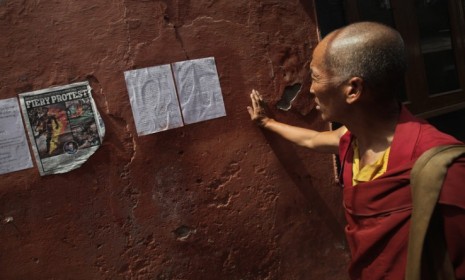Tibet's 'horrific' wave of self-immolations: An instant guide
The dramatic — and often fatal — form of protest has become an increasingly common way to call attention to China's policies in ethnic Tibetan regions

A Tibetan exile set himself on fire in India on Monday, during a march to protest the visit of Chinese President Hu Jintao. "From head to toe, he was full of fire," Dorjee Tseten, national director of Students for a Free Tibet, tells The New York Times. The activist, Jamphel Yeshi, is in severely critical condition, the latest casualty in a "horrific" wave of often-fatal protests against Chinese rule in Tibet. Here, a brief guide:
How common is this form of protest?
In the last year, roughly 30 people have set themselves on fire to protest Chinese rule of Tibetan areas. Twenty-two of them died. Many were Buddhist monks or nuns, and most of the immolations happened in China, usually in ethnic Tibetan parts of Sichuan and Qinghai provinces. But Yeshi wasn't the first such protester in India. Another man set himself on fire a few months ago in front of the Chinese embassy in India. In 1998, Thupten Ngodup self-immolated on the same spot as Yeshi, and later died.
The Week
Escape your echo chamber. Get the facts behind the news, plus analysis from multiple perspectives.

Sign up for The Week's Free Newsletters
From our morning news briefing to a weekly Good News Newsletter, get the best of The Week delivered directly to your inbox.
From our morning news briefing to a weekly Good News Newsletter, get the best of The Week delivered directly to your inbox.
Is the tactic working?
Not exactly. It's not as if China is now planning to surrender control of Tibet. Nor is there any indication the immolations will "lead to a broad uprising," says Gillian Wong at The Associated Press. "But they have embarrassed Beijing and are testing Chinese policies across the Tibetan plateau." And the shocking images have called worldwide attention to complaints about what Tibetans say is China's repression of their religion and culture, along with showing that opposition to Beijing's rule is growing.
How has China reacted?
A state-run Chinese website, China Tibet Online, and the official Xinhua News Agency blamed the phenomenon on the Dalai Lama, bitterly accusing the exiled spiritual leader of encouraging Tibetans to set themselves on fire to further what they called his "Nazi" racial policies. The Dalai Lama fled Tibet in 1959, and many of the protesters and their supporters have called for his return. The Dalai Lama said the self-immolations are "very, very sad" and a "very sensitive, political issue."
A free daily email with the biggest news stories of the day – and the best features from TheWeek.com
Is there reason to believe there will be more?
That appears likely, says Mark Memmott at NPR. Tibetans are growing increasingly more upset over China's policies in ethnic Tibetan regions. And the people who sacrifice themselves through such dramatic action are viewed as heroic in their communities, Nottingham University professor Steve Tsang tells Britain's Guardian. "I can't really see how it is going to stop."
Sources: Associated Press, BBC News, Guardian, New York Times, Wall Street Journal
-
 Wilde Cambridge: home-away-from-home in a prime city spot
Wilde Cambridge: home-away-from-home in a prime city spotThe Week Recommends This laid-back aparthotel is the perfect base for a weekend of exploring
-
 The best alcohol-free alternatives for Dry January
The best alcohol-free alternatives for Dry JanuaryThe Week Recommends Whether emerging from a boozy Christmas, or seeking a change in 2026, here are some of the best non-alcoholic beers, wines and spirits to enjoy
-
 A lemon-shaped exoplanet is squeezing what we know about planet formation
A lemon-shaped exoplanet is squeezing what we know about planet formationUnder the radar It may be made from a former star